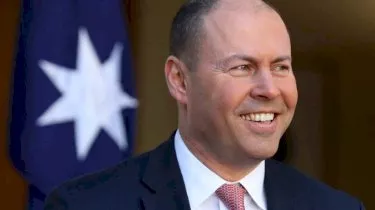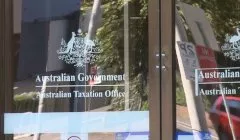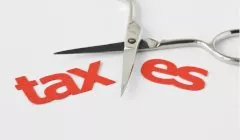Earn
Why the narrative around stage 3 tax cuts is wrong
As the debate around the government’s controversial stage 3 tax cuts continues, an economist reveals why ballooning taxes may not necessarily spell bad news for the Australian economy.
Why the narrative around stage 3 tax cuts is wrong
As the debate around the government’s controversial stage 3 tax cuts continues, an economist reveals why ballooning taxes may not necessarily spell bad news for the Australian economy.

The current narrative around Australian politics is that tax cuts increase consumer spending, with stage 3 tax cuts said to be vital to supporting the national economy moving forward.
But the tax cuts, set to come into effect in 2024, are poised to cost the government $137 billion between 2024 and 2030, by applying a standard 30 per cent income tax rate to those who earn between $45,000 and $200,000 a year.
For those earning more than $200,000, the tax rate would remain at 45 per cent, which is the current going rate for those who pocket $180,000 and more.
While Labor has long opposed the cuts, it is currently looking at capping the stage 3 cuts at $180,000 in a bid to save the government $80 billion.

“We do think that middle Australia deserves tax relief,” shadow treasurer Jim Chalmers previously said.
“We said at the time, and we’ve said ever since, that it didn’t make a lot of sense for the government to commit tens of billions of dollars to the highest-income earners some years down the track.”
Despite the Morrison government pushing the benefits of stage 3 tax cuts on the broader economy, Australian Institute senior economist Matt Grudnoff has argued that the narrative around the cuts is simply wrong.
During an interview with ABC’s Insiders, Treasurer Josh Frydenberg noted that stage 3 tax cuts inspire Australians to work harder.
“What you’re doing is you’re rewarding effort, you’re encouraging aspiration, you’re returning more people’s hard-earned money back to them,” he said.
However, Mr Grudnoff was quick to point out that numerous studies, including by the IMF, show that economies with lower inequality grow faster than economies with high inequality.
“The tax system is one of the best tools we have for fighting inequality as taxation revenue mainly comes from high-income earners. But the stage 3 tax cuts threaten this as they mainly go to high-income earners. These tax cuts will increase inequality,” he said.
“The argument that lower taxes on high-income earners are needed to make them work harder and longer is also wrong. There is no evidence that any CEO or other high-flyer has slackened because taxes are too high.”
While the income-tax scale becomes progressively higher depending on a person’s income, the government is arguing that flattening the curve removes bracket creep.
Prime Minister Scott Morrison argued back in 2018 when he was treasurer that removing bracket creep was part of his government’s seven-year plan, when the three-stage tax reform was first announced.
In the three years since, the government has stuck to the narrative.
Once again, Mr Grudnoff refuted these claims, highlighting that Australian taxpayers have been overcompensated for bracket creep and there is no need for further income tax cuts to reduce the effect.
“If we compare the impacts of inflation with the impact of income tax cuts, we can see that income tax cuts have been larger than inflation for income levels. The overcompensation is the largest the higher incomes become,” he said.
Finally, the government also pointed out that lowering taxes, including those in stage 3, will act as an economic stimulus due to increasing consumer spending.
In a move aimed to further shore up consumer spending, the government used the budget to extend the low and middle income tax offset, giving 10 million workers a tax cut of between $255 and $1,080, at a cost of $7.8 billion.
When asked what “growth dividend” the tax cuts would deliver, the Treasurer said they would “deliver a stronger economy over time”.
“What you’re doing is you’re rewarding effort, you’re encouraging aspiration, you’re returning more people’s hard-earned money back to them,” he said.
“You see economic growth through the years in our budget, including this year.”
Unsurprisingly, Mr Grudnoff disagreed with this narrative, pointing out that high-income earners make poor economic stimulus because they are more likely to save the extra funding rather than spending.
“The higher the household’s income, the more they tend to save. This means a large proportion of any tax cut that go to high-income earners will be saved, and its stimulatory effect will be much smaller,” he said.
The Australian Institute also noted that the government, when it legislated the stage 3 tax cuts in 2018 and then again when they increased them in 2019, said that they were affordable because of the expected strong economic growth out to 2024.
“The government was arguing that when times were good, we should cut taxes.
"Since 2019, the economy has collapsed into recession following the coronavirus pandemic. The government is now effectively arguing that when times are bad, we need the same tax cuts,” Mr Grudnoff concluded.
About the author

About the author


Tax refund
How a $140k 'repair' became a tax strategy triumph and competitive edge
A Sydney investor secured an immediate deduction for $140,000 in rental property works after the ATO initially treated the spend as capital. In a market where the ATO says most rental schedules ...Read more

Tax refund
The ATO will be focusing on these four issues at tax time
The tax office has indicated it will be scrutinising areas where taxpayers are known to make mistakes. Read more

Tax refund
More than half of Aussies get stressed at tax time, survey finds
Many taxpayers feel that they may be missing out on deductions in their tax returns. Read more

Tax refund
Engage or face firmer action, ATO warns taxpayers with unpaid debts
The tax office is offering support and assistance to those with overdue debts. Read more

Tax refund
How to prepare for your tax return
While the end of the financial year is still a couple of months away, you can take action now to help maximise your tax return. Read more

Tax refund
What issues will be on the ATO’s radar this year?
H&R Block has outlined two main areas that the tax office is expected to focus on. Read more

Tax refund
How does the expanded low and middle income tax offset work?
Millions of taxpayers will receive hundreds of dollars more in their tax return this year. Read more

Tax refund
Why 90% of taxpayers could face a higher tax bill next financial year
A tax offset for over 10 million Aussies may not be extended in next month’s budget. Read more

Tax refund
How a $140k 'repair' became a tax strategy triumph and competitive edge
A Sydney investor secured an immediate deduction for $140,000 in rental property works after the ATO initially treated the spend as capital. In a market where the ATO says most rental schedules ...Read more

Tax refund
The ATO will be focusing on these four issues at tax time
The tax office has indicated it will be scrutinising areas where taxpayers are known to make mistakes. Read more

Tax refund
More than half of Aussies get stressed at tax time, survey finds
Many taxpayers feel that they may be missing out on deductions in their tax returns. Read more

Tax refund
Engage or face firmer action, ATO warns taxpayers with unpaid debts
The tax office is offering support and assistance to those with overdue debts. Read more

Tax refund
How to prepare for your tax return
While the end of the financial year is still a couple of months away, you can take action now to help maximise your tax return. Read more

Tax refund
What issues will be on the ATO’s radar this year?
H&R Block has outlined two main areas that the tax office is expected to focus on. Read more

Tax refund
How does the expanded low and middle income tax offset work?
Millions of taxpayers will receive hundreds of dollars more in their tax return this year. Read more

Tax refund
Why 90% of taxpayers could face a higher tax bill next financial year
A tax offset for over 10 million Aussies may not be extended in next month’s budget. Read more










